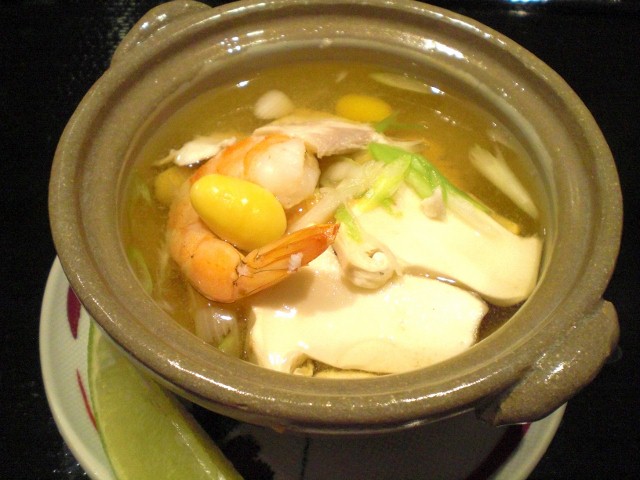This is a classic dish utilizing matsutake 松茸. It is a type of clear soup but you enjoy the broth and the items in the broth separately. This dish is made in a special "dobin" 土瓶 container (a type of rustic teapot) with a small sake cup or guinomi ぐい飲み so that the exquisite broth can be poured into the cup and enjoyed. Then diving into the pot, the matsutake and other ingredients can be savored. Since I do not own a "dobin", I served this in a mini-donabe. In the classic method, after putting the ingriedents and broth in the dobin, it is steamed ("mushi" means "to steam") but I made everything in a sauce pan. I served this with a porcelain spoon ちりれんげ and a small guinomi sake cup so that we could enjoy the broth and the matsutake and other items separately.

Broth: For this dish, I think you have to make the dashi from scratch. I made a classic ichiban dashi 一番だし with kelp and bonito flakes. I seasoned it with light colored soy sauce, sake, mirin and salt. I did not want a very strong seasoning here. The main ingredient is matsutake--you have to let it speak for itself. When matsutake is cooked with other ingredients in the borth, it becomes much more complex albeit still very subtle.
Other items: Many cooks use chicken meat for this dish but I do not. Chicken is too strong even breast meat. Instead I used thinly sliced pieces of fluke (a type of flounder or other white meat fish without a strong flavor), boiled ginko nuts or "ginnan" 銀杏 (from a can in my case), small shrimp (frozen) and thinly sliced scallion. In a gently simmering seasoned broth, I placed the fish first, shrimp, ginnan and matsutake and gently cooked (or warmed through) for a few minutes. I then put sliced scallion (More traditional condiment will be "mitsuba" 三つ葉 but I did not have it.) If available, a Japanese citrus called "kabosu" カボス, which is very similar to "yuzu" 柚子 is traditionally used. Since I do not have easy access to those, I served it with a wedge of lime. Just before eating, I squeezed the lime juice over the dish. The way to enjoy this dish is to sip the broth and then have some mushroom etc. (Did I say etc? I was told nobody uses "et cetra" any longer. My wife told me etc. means "entire thought collapse"). This was a reasonable approximation of the classic dish. You definitely need cold sake for this delicate dish.

No comments:
Post a Comment